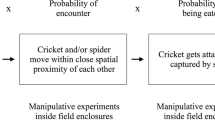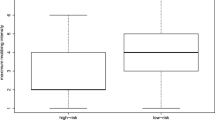Summary
Mate detection success of male grey-sided voles,Clethrionomys rufocanus, in relation to the spatial distribution of sexually receptive females was studied in an experimental island population. The spatiotemporal distribution of receptive females was controlled by containing females in small, mobile wire-mesh cages, whereas the response by free-ranging males was monitored by means of radiotelemetry. Males were on average more successful in finding oestrous females when females were spatially clumped than when females were spatially overdispersed. In addition, the variance (CV) in male mate detecting success was highest when females had an overdispersed spatial distribution. These results are consistent with predictions from a theoretical model (Ims, 1988b) analysing the effect of mate distribution on male mating success, and with empirical results on prey detection success of predators searching for prey.
Similar content being viewed by others
References
Eisenberg, J. F. (1981)The mammalian radiation. University of Chicago Press, Chicago.
Emlen, S. T. and Oring, L. W. (1977) Ecology, sexual selection, and the evolution of mating systems.Science 197, 215–23.
Ims, R. A. (1987) Male spacing systems in microtine rodents.Amer. Natur. 130, 475–84.
Ims, R. A. (1988a) The potential for sexual selection in males: effects of sex ratio and spatiotemporal distribution of receptive females.Evol. Ecol. 3, 338–52.
Ims, R. A. (1988b) Spatial clumping of sexually receptive females induces space sharing among male voles.Nature 335, 541–3.
Kawata, M. (1985) Mating system and reproductive success in a spring population of the red-backed vole,Clethrionomys rufocanus bedfordiae. Oikos 45, 181–90.
Kawata, M. (1988) Mating success, spatial organization, and male characteristics in experimental field populations of the red-backed vole,Clethrionomys rufocanus bedfordiae.J. Anim. Ecol. 57, 217–35.
McFarlane, J. D. and Taylor, J. M. (1982) Nature of oestrus and ovulation inMicrotus townsendii.J. Mamm. 63, 104–9.
Parker, G. A. (1978) Searching for mates. InBehavioural Ecology: an Evolutionary Approach (J. R. Krebs and N. B. Davies, eds) pp. 30–61. Blackwell Scientific, Oxford.
Schwagmeyer, P. L. and Woontner, S. J., (1986) Scramble competition polygyny in the thirteen-lined ground squirrel: the relative contribution of overt conflict and competitive mate searching.Behav. Ecol. Sociobiol. 19, 359–64.
Schwagmeyer, P. L. and Parker, G. A. (1987) Queueing for mates in thirteen-lined ground squirrels.Anim. Behav. 35, 1115–25.
Sih, A. (1982) Optimal patch use: variation in selective pressure for efficient foraging.Amer. Natur.,120, 666–85.
Taylor, R. J. (1984)Predation. Chapman and Hall, London and New York.
Thornhill, R. and Alcock, J. (1983)The evolution of insect mating systems. Harvard University Press, Cambridge, USA.
Author information
Authors and Affiliations
Rights and permissions
About this article
Cite this article
Ims, R.A. Mate detection success of maleClethrionomys rufocanus in relation to the spatial distribution of sexually receptive females. Evol Ecol 4, 57–61 (1990). https://doi.org/10.1007/BF02270715
Issue Date:
DOI: https://doi.org/10.1007/BF02270715




